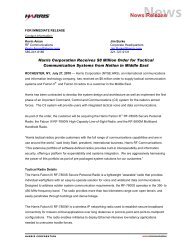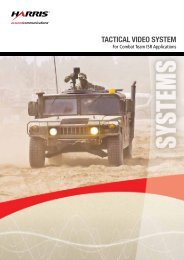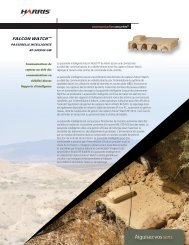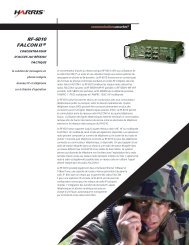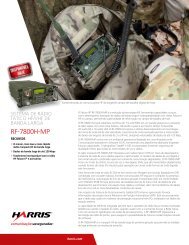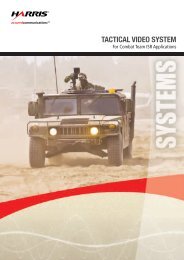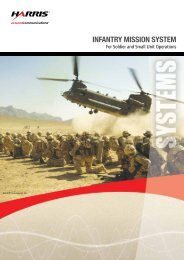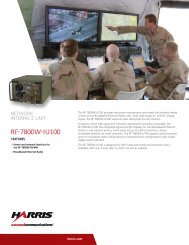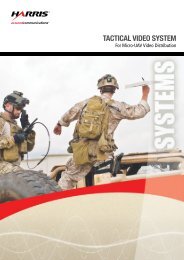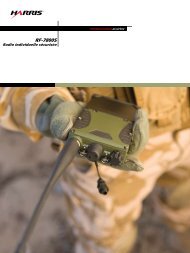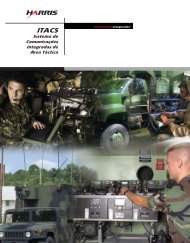TACTiCAl MEDiCAl TriAgE SYSTEM - Harris Corporation
TACTiCAl MEDiCAl TriAgE SYSTEM - Harris Corporation
TACTiCAl MEDiCAl TriAgE SYSTEM - Harris Corporation
Create successful ePaper yourself
Turn your PDF publications into a flip-book with our unique Google optimized e-Paper software.
TACtical MEDical triage <strong>SYSTEM</strong><br />
For Soldier and Small Unit Operations
Photo credit: U.S. Air Force Tech. Sgt. Joanna Hensley<br />
The manual method of documenting<br />
battlefield injuries is no longer sufficient
Packaged Systems<br />
A simpler approach to C4ISR systems procurement<br />
Quickly capturing and communicating medical data are<br />
critical challenges that are not being effectively met on<br />
today’s battlefield. There is a compelling need to send<br />
medical information back to a triage station before an injured<br />
patient arrives for care. The Tactical Medical Triage System<br />
leverages <strong>Harris</strong>’ handheld computing and wideband networking<br />
radio capabilities to record soldiers’ medical data in the field and<br />
deliver it to doctors in real time, while automatically updating a<br />
remote medical database.<br />
Procuring a complex Command, Control, Communications, and<br />
Computers (C4) system is usually no easy matter. Too often<br />
customers spend substantial time and resources, only to find<br />
themselves behind schedule and over budget with a system that<br />
does not meet their requirements. <strong>Harris</strong> <strong>Corporation</strong>’s new,<br />
simplified approach to C4ISR* systems procurement uses preengineered<br />
system configurations that provide fast, cost-effective<br />
solutions to today’s most critical operational needs, such as<br />
tactical medical triage.<br />
Instead of designing a unique system for every customer, <strong>Harris</strong><br />
has developed a comprehensive family of preconfigured systems.<br />
Each system is fully integrated and includes all equipment, cables,<br />
software, and manuals, with training and installation available.<br />
Every system has undergone extensive testing and can be relied<br />
upon to meet its objectives.<br />
This executive summary describes the Tactical Medical Triage<br />
System and outlines the advantages of our packaged C4ISR<br />
systems:<br />
l Low Risk – Field proven and comprehensively tested systems<br />
provide existing, cost-effective solutions<br />
l Fast Delivery – Complete systems can be delivered in a matter<br />
of months to meet urgent operational needs<br />
l Simplified Procurement – Systems can be purchased as<br />
off-the-shelf items, eliminating long system definition and<br />
development phases<br />
l Phased Implementation – Packaged systems form building<br />
blocks that enable the incremental acquisition of capability<br />
l Flexibility – Packaged systems are readily customized and can<br />
be integrated by in-country partners<br />
All this from <strong>Harris</strong>, a company with over 50 years of large-scale<br />
international communications systems experience, the most<br />
comprehensive range of tactical communications products, and<br />
world-class systems engineering and integration capabilities.<br />
*C4ISR = Command, Control, Communications, Computers,<br />
Intelligence, Surveillance, and Reconnaissance<br />
Contact <strong>Harris</strong> now to discuss your C4ISR systems needs:<br />
www.harris.com/systems<br />
1
THE OPERATIONAL challenge<br />
Seamless capture and transfer of medical data<br />
to save lives on the battlefield<br />
Combat medics must not only treat patients under<br />
battlefield conditions, but also document the injuries<br />
and their treatment. This information needs to be rapidly<br />
dispatched to a medical center so that time-critical care can be<br />
planned and provided. Currently there is no integrated system<br />
that supports both the recording and transmission of this<br />
medical data in theater. Doctors are therefore not receiving this<br />
important—sometimes lifesaving—information quickly enough<br />
to effectively manage treatment.<br />
Today’s in-field data capture methods do not provide a quick and<br />
efficient means for recording medical information. The standard<br />
method is to simply write on a patient’s body or a paper form<br />
with a grease pencil. More advanced methods involve using a<br />
PDA to generate an electronic record, but these have numerous<br />
drawbacks. The complicated user interface makes them<br />
cumbersome and difficult to use. In fact, the process of collecting<br />
data at the time of an injury typically requires extensive use of<br />
both hands. This can interfere with overall patient care or require<br />
additional assistance for transcription.<br />
Another major drawback with current systems is that the injury<br />
and treatment data remains with the patient or medic; this<br />
information can be easily lost or compromised in the field.<br />
Doctors are therefore not prepared to immediately treat the<br />
patient, and critical care is delayed while the pertinent data is<br />
collected again.<br />
Many militaries have established medical data repositories<br />
to ensure that injury data and medical treatment information<br />
are available for follow-on treatments, rehabilitation, and<br />
determination of wartime benefits. Since the data manually<br />
captured at the point of injury does not automatically populate<br />
a centralized data repository, the medic must manually enter<br />
the information into a computer at the treatment facility. Any<br />
information that was recorded on a PDA-based system also<br />
requires an additional step to synchronize it with the database,<br />
since current devices do not transmit the data over tactical radio<br />
networks.<br />
The main liabilities of the current systems include:<br />
l Inability to supply triage data to doctors prior to patient arrival<br />
l Manual data entry methods that require the use of one or<br />
both hands<br />
l Inability to wirelessly transmit data to or update medical<br />
databases<br />
l Documentation of medical status requires additional steps<br />
l Data from the point of injury is often lost or damaged,<br />
possibly impacting outcomes<br />
The optimal solution would convey medical triage data from field<br />
medics to waiting doctors—and into the healthcare system at<br />
large—with a design that is both cost-effective and adaptable to
Every second counts when a soldier has<br />
been injured, and the Tactical Medical<br />
Triage System ensures that critical data<br />
flows to the next level of care quickly<br />
and efficiently<br />
Photo Courtesy of U.S. Army. Photo credit: Sgt. Jesse Houk<br />
changes in technology. Additionally, it should provide enhanced<br />
capabilities to allow medics to capture this data easily and<br />
efficiently, in parallel with patient care.<br />
With its Tactical Medical Triage System that features an intuitive,<br />
voice-driven user interface, <strong>Harris</strong> provides a stand-alone<br />
solution that also can be integrated into a larger network of our<br />
wideband radios. In short, the system enables more responsive<br />
and effective treatment at the time of injury and facilitates<br />
medical record-keeping.<br />
The <strong>Harris</strong> Tactical Medical Triage System<br />
provides medics:<br />
l Real-Time Data Transfer – With seamless transmission of<br />
pictures, audio, and medical records from the point of injury<br />
over the <strong>Harris</strong> network infrastructure and automatic update<br />
of centralized data repositories<br />
l E-Records from Standard Forms – Generates and updates<br />
records based on standard forms such as the Tactical Combat<br />
Casualty Care Card (TCCC) and Field Medical Card (DD-1380)<br />
l “Store and Forward” Capability – Safeguards data by<br />
automatically storing medical information locally when<br />
communications are not available, and pushing records to the<br />
database when the link is restored<br />
l Extended Capabilities – Providing on-the-move access to<br />
applications such as medical reference and medical supply<br />
inventory programs<br />
3
solution overview<br />
Improving continuity of care on the battlefield<br />
The Tactical Medical Triage System uses the advanced<br />
networking capabilities of the new Falcon III family of<br />
tactical radio products and the <strong>Harris</strong> Ruggedized Tablet<br />
running the specialized TacMed application. This IP-based system<br />
can collect and distribute data from the point of injury to its final<br />
destination.<br />
In a typical scenario, an injury occurs in theater and a medic is<br />
deployed to the location. He captures the details of both the<br />
injury and treatment through the TacMed application, using the<br />
hands-free interface while providing medical care.<br />
Once all the necessary information is recorded, it is disseminated<br />
to a medevac helicopter (if required), triage station, and<br />
centralized database using a tactical communications link,<br />
ensuring continuity of patient care.<br />
The next-level care facilities can receive medical information from<br />
multiple deployed Tactical Medical Triage Systems. Doctors and<br />
other health care professionals are able to view and analyze the<br />
medical data before incoming patients arrive for care.<br />
Key Features:<br />
l Easy-to-Use, Intuitive Interface – Multiple means of<br />
collecting medical information—including voice-driven,<br />
hands-free input—allows medics to perform critical job<br />
functions and generate electronic medical records at the same<br />
time.<br />
l Open Standards, IP-Based Communications – Allows<br />
networked distribution and access of medical information<br />
across <strong>Harris</strong> tactical radios and other equipment, overcoming<br />
existing architecture gaps.<br />
l Scalability – The network can be expanded simply by<br />
deploying multiple instances of the Tactical Medical Triage<br />
System or by adding system components at any site.<br />
l Flexible Connectivity – The <strong>Harris</strong> integrated radio<br />
networking waveforms and communications products<br />
automatically establish self-forming, self-healing, mesh<br />
networks that enable medics to route medical information<br />
to a forward deployed triage station.<br />
l Customized Off-the-Shelf Availability – The Tactical<br />
Medical Triage System is a <strong>Harris</strong> packaged system based on<br />
ruggedized military equipment. It is available for delivery now<br />
and can be readily customized as required.
Photo credit: U.S. Navy photo by<br />
Special Warfare Operator 1st Class<br />
(SEAL) Joel Beam<br />
To facilitate continuity of care, the patient’s vitals, onsite treatment,<br />
and other details enter the health care system at the point of injury<br />
5
low-risk solution<br />
The Tactical Medical Triage System<br />
is ready for delivery<br />
A<br />
standard Tactical Medical Triage System includes sufficient<br />
equipment for two medics to independently collect intheater<br />
medical data and disseminate it in real time to a<br />
forward deployed triage station.<br />
The standard system can typically be delivered within four<br />
months and includes:<br />
l Two handheld dismount kits, each with a Multiband<br />
Networking Handheld (MBNH) and a Haris Ruggedized<br />
Tablet with the <strong>Harris</strong> TacMed application<br />
l A relay data kit which includes a Multiband Networking<br />
Radio (MBNR) in a vehicular configuration for relaying and<br />
distributing the collected medical triage data<br />
l A triage data kit which includes an MBNR and a Windowsbased<br />
ruggedized laptop capable of securely receiving and<br />
storing the collected medical data<br />
The dismount kit enables the collection of data at the point of<br />
injury via the TacMed application running on the tablet. This kit’s<br />
handheld MBNH radio provides a means to transmit the medical<br />
data in the form of voice, images and text to the triage station<br />
through an Adaptive Networking Wideband Waveform (ANW2)<br />
mobile, ad hoc IP data network. The relay kit supports the data<br />
transport, while also providing additional ANW2 range for data<br />
distribution, and the triage kit is where all data is received.<br />
Through the use of both an MBNR and PC with the TacMed<br />
database application, all of the medical information collected<br />
at the point of injury is at the disposal of the doctors who need<br />
it most.<br />
This configuration is very flexible, and additional functionality<br />
and alternate equipment sets are easily incorporated, either at<br />
initial purchase or as a subsequent upgrade. Typical add-ons<br />
include:<br />
l Acquiring additional dismount, relay, or triage kits for larger<br />
scale deployments<br />
l Third-party Android applications such as medical reference<br />
and inventory programs<br />
Additional connectivity options are available including:<br />
l Extended relay range using <strong>Harris</strong> SATCOM or High Capacity<br />
Line-of-Sight radios<br />
l Tactical cellular integration with <strong>Harris</strong> 3G or 4G LTE kits<br />
which leverage the onboard cellular capabilities of the tablet<br />
l Simultaneous distribution of medical data to multiple triage<br />
stations<br />
l Remote access to the medical data via an existing military<br />
network or from a tactical operations center
Order<br />
Received<br />
Equipment<br />
Procurement<br />
60 days<br />
Kit<br />
Integration<br />
15 days<br />
Acceptance<br />
Testing<br />
15 days<br />
Optional Installation<br />
in Trailer or Vehicle<br />
5 days<br />
Training<br />
5 days<br />
Delivery<br />
Complete<br />
1 2 3 MONTHS<br />
4<br />
Shipping<br />
10 days<br />
Site<br />
Acceptance<br />
Testing<br />
10 days<br />
Order<br />
Received<br />
Equipment<br />
Procurement<br />
70 days Kit<br />
Integration<br />
15 days<br />
Acceptance<br />
Testing<br />
15 days<br />
Training<br />
10 days<br />
1 2 3<br />
4<br />
MONTHS<br />
Typical Four-Month Delivery Schedule<br />
Delivery<br />
Complete<br />
Shipping<br />
10 days<br />
Site<br />
Acceptance<br />
Testing<br />
5 days<br />
Low-Risk System Characteristics:<br />
l Pre-engineered system implementation<br />
l Integration risks are eliminated<br />
l Standard interfaces and protocols ease incorporation of future enhancements<br />
l Leverages the combat-proven <strong>Harris</strong> Falcon III ® radio technology<br />
l Expandable, with ability to add features and equipment<br />
7
system description<br />
Distributing medical triage data in a scalable<br />
and cost-effective manner<br />
The Tactical Medical Triage System supports dissemination<br />
of electronic medical data in a hierarchical deployment<br />
environment. Its primary function is to provide medical<br />
information to doctors in theater in real time, enabling prompt<br />
and effective treatment of battlefield injuries. In the example<br />
deployment shown below, information collected by the medics<br />
is transmitted to the relay and distributed to the triage center for<br />
storage in a centralized database, for dissemination to doctors.<br />
Medical data is collected in the field at the dismount level<br />
using the <strong>Harris</strong> RF-3590 Ruggedized Tablet and <strong>Harris</strong> TacMed<br />
application. Leveraging embedded voice recognition technology,<br />
TacMed provides a voice-driven interface which allows hands-free<br />
navigation and data entry. This provides the medic with full use<br />
of both hands to care for patients.<br />
Once the data is entered, the system’s built-in “store and<br />
forward” capability safeguards the medical records locally on the<br />
tablet when communications are not available; the information is<br />
automatically pushed to the database when the link is restored.<br />
The medic, relay, and triage levels are connected using the<br />
Adaptive Networking Wideband Waveform (ANW2) running on<br />
the <strong>Harris</strong> radios. This mobile, ad hoc networking waveform<br />
(MANET) enables simultaneous voice and data communications<br />
for coordination or follow-up on any medical data transmitted.<br />
To support rapid setup in the widest possible range of<br />
applications, the Tactical Medical Triage System equipment<br />
is delivered in lightweight, portable cases. Relay kits can be<br />
installed in a variety of vehicles or deployed at fixed locations.<br />
And the flexible design of the <strong>Harris</strong> networking radio waveforms<br />
makes the system highly scalable; medical data distribution to<br />
additional units is enabled by simply adding equipment at the<br />
desired echelons.<br />
In addition to the tactical radio products outlined above, the<br />
dismount kits can be augmented with the <strong>Harris</strong> Tactical Cellular<br />
System, providing 3G or 4G LTE. As shown in the diagram, triage<br />
and relay sites can be optionally outfitted with vehicular and<br />
portable Broadband Global Area Network (BGAN) SATCOM and<br />
High Capacity Line-of-Sight (HCLOS) kits.<br />
An optional Tactical Operations Center (TOC) kit also can be<br />
added to provide full integration into the tactical network.<br />
This would provide storage to route all captured data back<br />
to a centralized location, as well as the ability to retrieve any<br />
previously generated information.<br />
BGAN<br />
Military<br />
Network<br />
HCLOS<br />
ANW2<br />
TOC<br />
TRIAGE<br />
ANW2<br />
ANW2<br />
RELAY<br />
ANW2<br />
DISMOUNT
Tactical Medical Triage System Configuration<br />
TRIAGE KIT<br />
TOC KIT<br />
HCLOS KIT<br />
RELAY KIT<br />
VEHICULAR BGAN KIT<br />
PORTABLE BGAN KIT<br />
DISMOUNT KIT<br />
TACTICAL CELLULAR KIT<br />
MBNR DISMOUNT KIT<br />
STANDARD CONFIGURATION<br />
OPTIONAL CAPABILITIES<br />
RF-7600P-SU501 Tactical Medical Triage System Equipment<br />
Standard Configuration<br />
Triage Kit (Qty 1)<br />
Relay Kit (Qty 1)<br />
Dismount Kit (Qty 2)<br />
l RF-7800M-MP Multiband Networking Radio (MBNR) in a 50W Base Station configuration<br />
including Vehicular amplifier adapter (VAA)<br />
l Windows-based laptop with onboard storage and the TacMed database application for<br />
management and distribution of collected medical data<br />
l RF-7800M-MP MBNR in a 50W Vehicular System configuration<br />
l VAA for vehicle power conditioning and external power output for accessories such as<br />
loudspeakers and battery chargers<br />
l RF-7800M-HH Multiband Networking Handheld (MBNH) including antennas, cables, carrying<br />
case, spare battery, and charger<br />
l RF-3590 <strong>Harris</strong> Ruggedized Tablet including charging and data cables, docking station and<br />
connectors, spare battery, and battery charger<br />
l TacMed Android Application<br />
Optional Capabilities<br />
l Tactical Operations Center (TOC) Kit<br />
l HCLOS Kit<br />
l Vehicular BGAN Kit<br />
l Portable BGAN Kit<br />
l Tactical Cellular Kit<br />
l MBNR Dismount Kit<br />
9
ENABLING TECHNOLOGIES<br />
<strong>Harris</strong> tablets and wideband radios empower<br />
the system’s advanced capabilities<br />
The wideband nature of the Falcon III ® radios, along with<br />
our advanced data processing and edge device capabilities,<br />
enables <strong>Harris</strong> to provide an off-the-shelf Tactical Medical<br />
Triage System.<br />
<strong>Harris</strong> Ruggedized Tablet<br />
Medics will rely upon the robust capabilities of the <strong>Harris</strong><br />
Ruggedized Tablet to seamlessly record and transmit medical<br />
information in theater. It is an Android-based tablet with a 7˝<br />
multi-touch, sunlight readable display, which can be tethered<br />
to a <strong>Harris</strong> radio and also can communicate via built-in USB,<br />
10/100 Ethernet, or Bluetooth. With a Mini PCIe Cellular Modem<br />
slot with Dual SIM card support, the tablet can be configured to<br />
leverage 3G or 4G LTE.<br />
The heart of the tablet is a dual core, 1.5 GHz processor with<br />
2 GB of LPDDR2 memory and 128 GB of internal non-volatile<br />
memory (NVM). The device supports an SD card for removable<br />
storage and a USB Host and OTG ports for ancillary USB<br />
devices. An embedded sensor array includes an accelerometer,<br />
inclinometer, digital compass, barometric pressure gauge,<br />
thermometer, gyroscope, and proximity/ambient light sensors,<br />
providing the medic with a flexible tool for whatever the<br />
mission requires. Additional supported outputs include an HDMI<br />
interface, ancillary transceiver module (ATM), and a docking<br />
connector.<br />
The tablet features front and rear facing cameras for capturing<br />
visual details of the injury and treatment, while multiple<br />
microphones support the system’s advanced noise cancelling and<br />
voice recognition technology. This capability enables the TacMed<br />
application to capture medical data quickly through an intuitive,<br />
voice-driven user interface, for real-time update of a centralized<br />
medical repository.<br />
Multiband Networking Radios<br />
Military units that need to view and transmit medical data and<br />
also communicate by voice will utilize the strengths of the <strong>Harris</strong><br />
multiband radios. In the standard configuration, medics will use<br />
the RF-7800M-HH Multiband Networking Handheld (MBNH),<br />
while the relay and triage sites will each be outfitted with the RF-<br />
7800M-MP Multiband Networking Radio (MBNR) manpack.<br />
The RF-7800M enables the high-speed flow of combat medical<br />
information across a secure, mobile, tactical wireless network—<br />
enabling the critical connection between in-field forces and upechelon<br />
command platforms and treatment facilities. The MBNR<br />
incorporates the ANW2 waveform which can transmit data at<br />
rates up to 5 Mbps and an advanced, mobile, ad hoc networking<br />
(MANET) protocol.<br />
The MANET network automatically forms between the available<br />
nodes and self-heals as nodes go in and out of range. The result<br />
is that data captured in the field can be immediately shared with<br />
other units and triage specialists, even when on the move. The<br />
increased flow and timeliness of health status information in<br />
theater enables doctors to make faster, more informed decisions.
FEATURES<br />
Benefits<br />
<strong>Harris</strong> Ruggedized Tablet RF-3590<br />
Rugged, Lightweight<br />
Portability<br />
Flexible User Interface<br />
and Redundant Control<br />
Wireless Networking<br />
Weighing in at 2 pounds, the <strong>Harris</strong> tablet is built to MIL-STD-810G<br />
and MIL-STD-461F specifications for exceptional performance under<br />
battlefield conditions<br />
The user can navigate and enter data by three different means:<br />
l Audio commands<br />
l Multi-touch screen that works with bare or gloved fingers<br />
l Dual optical track pads<br />
Enables stand-alone communications via cellular 3G/4G LTE,<br />
Wi-Fi (802.11n), and Bluetooth 4.0 BLEANT<br />
Multiband Networking Radios RF-7800M<br />
High-Speed Waveform<br />
Ad Hoc Networking<br />
Simultaneous Voice and Data<br />
With the manpack radio supporting data rates up to 5 Mbps, the<br />
Adaptive Networking Wideband Waveform (ANW2) provides<br />
the necessary bandwidth for transmitting emergency medical data<br />
to the next level<br />
Keeps mobile nodes connected to the network to expand the<br />
deployed range; eliminates the need for extensive preplanning of<br />
networks before a mission<br />
Allows real-time discussion and coordination of medical data<br />
transmitted to the triage/treatment centers<br />
11
service offering<br />
After-sales service supports<br />
mission-critical systems worldwide<br />
<strong>Harris</strong> has earned a worldwide reputation as the low-risk<br />
vendor of choice for tactical radios and systems, with 99<br />
percent of our international program customers reporting<br />
that <strong>Harris</strong> meets or exceeds their expectations. Our responsive<br />
program management team and customer service organization<br />
will deliver and support a highly capable medical triage<br />
communications system.<br />
An agile manufacturing process enables <strong>Harris</strong> to modify<br />
production to meet customer demands. With one of the highestvolume<br />
defense communications manufacturing facilities in the<br />
world, we have the commitment and capability to deliver on<br />
our promises.<br />
Unlike many other companies, <strong>Harris</strong> has “boots on the ground”<br />
experience, supporting our products from initial fielding to<br />
obsolescence. In fact, we are currently servicing systems that have<br />
been deployed for more than 20 years, underscoring our absolute<br />
commitment to customer satisfaction. Our customers rate <strong>Harris</strong><br />
an average of two times higher than our nearest competitor.<br />
As a proven provider of advanced radio, sensor, and integrated<br />
systems to customers in over 120 countries, <strong>Harris</strong> has extensive<br />
experience in providing logistics and sustainment support<br />
throughout the world. We have developed highly successful<br />
processes for fielding, maintaining, supporting, repairing, and<br />
upgrading our equipment, no matter where it is deployed.<br />
Many of our product and technical service representatives have<br />
prior military experience, and establish a close, personal bond with<br />
our customers. Our comprehensive service offering includes classic<br />
telephone and email support as well as web-based services. The<br />
<strong>Harris</strong> Premier website (https://premier.harris.com/) provides<br />
customized access to:<br />
l Computer-based training courses and manuals<br />
l Frequently asked questions<br />
l Application notes<br />
l Purchase of accessories and ancillaries<br />
Customers also can use the website to:<br />
l Download and track software upgrades<br />
l Receive warranty and maintenance support, including RMA<br />
numbers and returned goods status<br />
System training is another important consideration. <strong>Harris</strong> trains<br />
approximately 5,000 students per year on the installation,<br />
operation, and maintenance of its equipment and systems. This<br />
process occurs in our company classrooms, at customer locations,<br />
and in the field. Our students (our customers) consistently rate the<br />
training they receive as meeting or exceeding their expectations.
The <strong>Harris</strong> Tactical Medical Triage System<br />
provides economic benefits throughout its<br />
entire life cycle:<br />
Low Risk – Our customer knowledge, program management,<br />
technical expertise, and world-class customer support serve to<br />
reduce fielding risk.<br />
High Performance – The open architecture design capitalizes<br />
on technology refresh of components, maximizing the value of<br />
customers’ investments over an extended time period.<br />
System Sustainment and Supportability – Sustainment issues<br />
are reduced by the use of rugged military equipment (with existing<br />
training and ILS packages) and the availability of <strong>Harris</strong> field<br />
service representatives.<br />
Life-cycle costs are reduced by:<br />
l Use of common equipment and software applications<br />
l 24/7 support capabilities<br />
l Available in-country training and training material<br />
l Common equipment interfaces and programming<br />
l Availability of installation and maintenance by in-country<br />
partners<br />
l Availability of extended warranties beyond the standard<br />
12 months<br />
l Low-cost upgrade paths<br />
13
proven performance<br />
<strong>Harris</strong> RFCD supplies tactical and public safety radio<br />
products in over 120 countries worldwide<br />
Millions of people and hundreds of government agencies<br />
throughout the world rely on assured communications ®<br />
solutions from <strong>Harris</strong> to deliver critical information to the<br />
right place at the right time. They know there is too much riding<br />
on the outcome to risk anything less. What sets <strong>Harris</strong> apart is our<br />
depth of expertise, breadth of experience, and focus on providing<br />
the most advanced products, systems, and services that meet or<br />
exceed the requirements of our customers.<br />
<strong>Harris</strong> is one of the only companies in the world specializing in<br />
advanced technology for capturing, aggregating, distributing,<br />
and analyzing the full range of wireless communications including<br />
voice, data, video, and imaging. We use this unique capability<br />
to provide systems and networks for customers in defense,<br />
intelligence, government, public safety, healthcare, broadcast,<br />
and energy markets.<br />
<strong>Harris</strong> RF Communications Division (RFCD) is the leading supplier<br />
of tactical, secure voice and data communications products,<br />
systems, and networks to military, government, and commercial<br />
organizations worldwide. More than 50 years of international<br />
experience is leveraged into the design and deployment of<br />
<strong>Harris</strong> RFCD’s packaged C4ISR system solutions.<br />
The Tactical Medical Triage System is one more example of <strong>Harris</strong><br />
responding to the needs of its customers.<br />
<strong>Harris</strong> has internationally<br />
acclaimed products which<br />
have left everyone else in<br />
the dust. l International Customer<br />
I firmly believe that <strong>Harris</strong> RF<br />
Communications really listens<br />
to their customer base and lives<br />
by the creed: the customer is<br />
king. I truly feel that sense of<br />
partnership with <strong>Harris</strong>, and<br />
I’ve been dealing with <strong>Harris</strong><br />
for years now. l NATO Staff Member
Always connected. Never alone.<br />
Corporate Headquarters<br />
RFCD Headquarters and Manufacturing<br />
RFCD Hubs<br />
RFCD Offices<br />
RFCD Partners<br />
Tactical Customers<br />
Public Safety Customers<br />
Tactical and Public Safety Customers<br />
Our proven solutions provide:<br />
l Voice, data, and video where it’s needed, when it’s needed<br />
l Cost effectiveness throughout the life cycle of the system<br />
• No long, costly development cycle<br />
• Unsurpassed in-country support during and after delivery<br />
l Scalability and growth options<br />
l Configurable solution sets<br />
l On-time delivery of quality systems<br />
15
the harris difference<br />
As your partner, <strong>Harris</strong> is committed to your success<br />
<strong>Harris</strong> <strong>Corporation</strong> welcomes the opportunity to discuss the<br />
Tactical Medical Triage System in more detail, and how it<br />
can be applied to your missions and applications.<br />
We believe that our packaged systems provide a significant value<br />
to you, our customer, in the following ways:<br />
l The systems are available now, eliminating long and expensive<br />
development and procurement cycles<br />
l The use of the latest wideband Falcon III ® tactical radios<br />
supports new operational capabilities that have not been<br />
previously possible<br />
l Falcon III software-defined radio technology uses open<br />
architectures and standard interfaces, allowing the system to<br />
incorporate new capabilities and stave off obsolescence<br />
l Pre-engineered system designs emphasize commonality of<br />
equipment and resources to reduce life-cycle sustainment costs<br />
such as training, sparing, and maintenance<br />
l Our systems engineers and in-country partners can readily<br />
customize the solution, as required<br />
l The systems are supported by our world-class customer service<br />
organization that operates in every part of the world and is<br />
second to none<br />
With approximately $6 billion (USD) in annual revenue, <strong>Harris</strong><br />
is an international communications and information technology<br />
company serving government and commercial markets worldwide.<br />
We are confident that our packaged C4ISR system solutions<br />
represent the best value with the lowest schedule, cost, and<br />
technical risks for meeting your complex operational challenges.<br />
Our solutions leverage:<br />
l Falcon III wideband radio technology<br />
l <strong>Harris</strong>‘ advanced edge device technology<br />
l Open standards and interfaces<br />
l Focused program teams<br />
l Over 50 years experience providing state-of-the-art military<br />
systems<br />
l Product service teams that deploy to our customer<br />
l Nearly 7,000 engineers and scientists throughout the<br />
corporation
Pushing data to the next level of care<br />
to improve outcomes and save lives<br />
17
Front Cover Photo credit: Department of the Army<br />
RF Communications Division | 1680 University Avenue | Rochester, NY USA 14610<br />
www.harris.com | 1-800-4-HARRIS | Telephone 585-244-5830<br />
Special thanks to the U.S. Air Force, U.S. Army, and U.S. Navy for providing some of the images used in this brochure.<br />
This information was approved for publishing per the ITAR as “Basic Marketing Information of Defense Articles” or per the EAR as “Advertising Printed Matter.”<br />
Specifications are subject to change without notice. © 2012 <strong>Harris</strong> <strong>Corporation</strong> 02/12 ES-121



